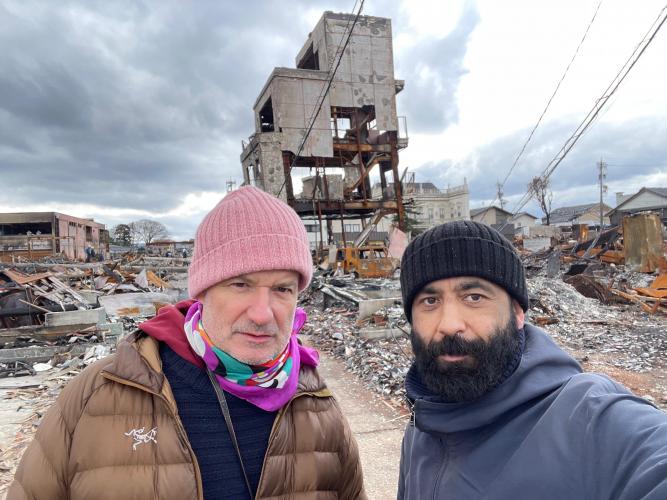Sweetcorn, Shrimp, and Macaroni (Noto Earthquake Roadmovie), 39min
A House Called Deer Head Park (Noto Earthquake Homemovie), 42 min
This new dual channel video work (shown at KLET in Landskrona, Sweden, in August 2025), took me again to Japan, after the 1995 film Un Ga Nai—Bad Luck. That film looked at the way Japanese culture deals with disaster by incorporating the psychology of catastrophe into the fundamental structure of society. Even if earthquakes in Japan are constantly anticipated and prepared for through public drills, the western coast of Japan was thought to be safe until the devastating Noto earthquake that occurred on January 1st, 2024.
A chance encounter between long-term Noto resident, draughtsman Tarek Al Abbar in Berlin one week before the quake, provided me with a unique chance to eye-witness the aftermath of the disaster just a few weeks later. This led to the two films in the exhibition subtitled, Noto Earthquake Road Movie, and Noto Earthquake Home Movie.
Tarek Al Abbar shows the affected peninsula and his house not without humour, while sharing his grief, his memories, and his hopes and dreams for the future—without knowing that the earthquake-damaged house he inhabits and where I was a guest was already slated for demolition by the Japanese government. By example, the two-channel piece attempts to diagnose the complexity of our feelings and possible psychological response at the thought of catastrophe.
On August 29, 2025, at the opening of the exhibition at KLET in Landskrona, Sweden, Tarek Al Abbar read a text that he had written in dialogue with the videos starring him:
In Tarek Al Abbar’s short reading, Beware of ______ Bearing Gifts, the artist introduces and confronts his alter ego, Taraku.
It is Taraku, not Tarek that appears in Christoph Draeger’s two video works — and though he seems unscripted and made of flesh and bone, to Al Abbar he is a puppet of Japanese circumstance, a typecast actor long past his expiration date. In the videos Al Abbar sees only a parody, as Taraku enacts one of the final scenes of his ten-year, self-imposed kabuki.
The reading traces the creation of this pseudo-Japanese persona and concludes with the account of his “cutting” demise. By invoking the blurred lines between lived reality and constructed role, Al Abbar’s narrative reflects on performance as a necessary condition for existing within the rigid structures of life along the Sea of Japan.
